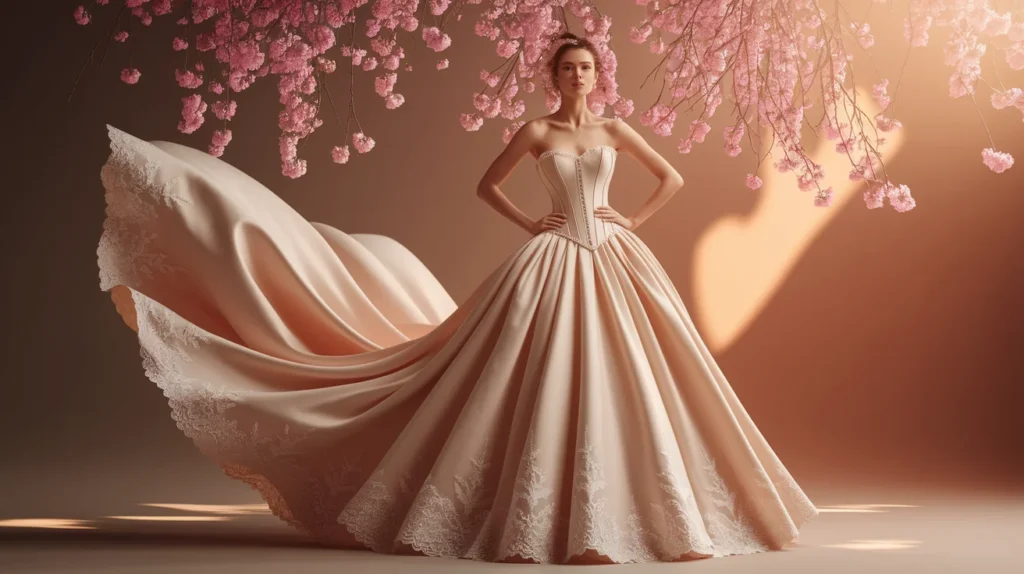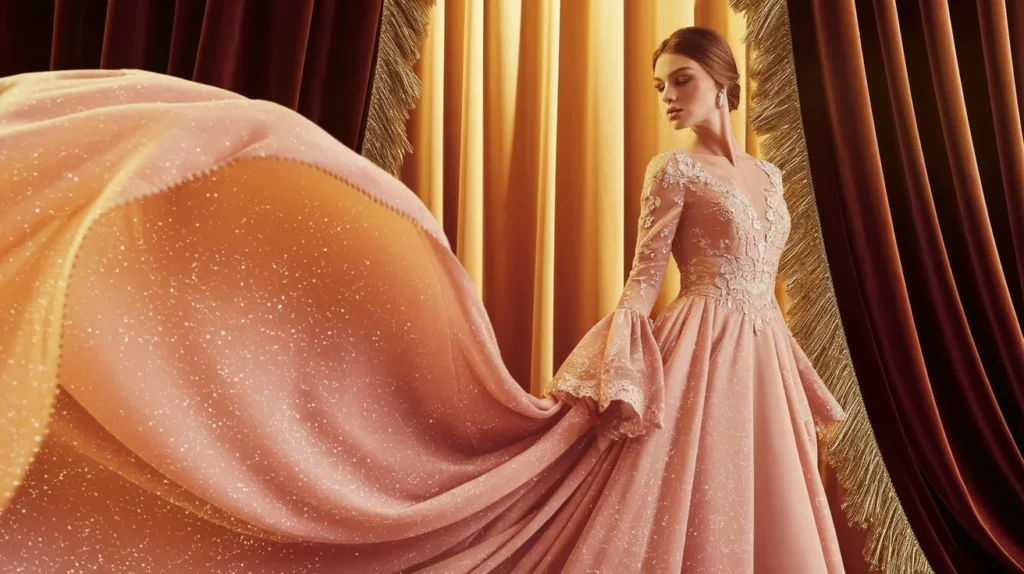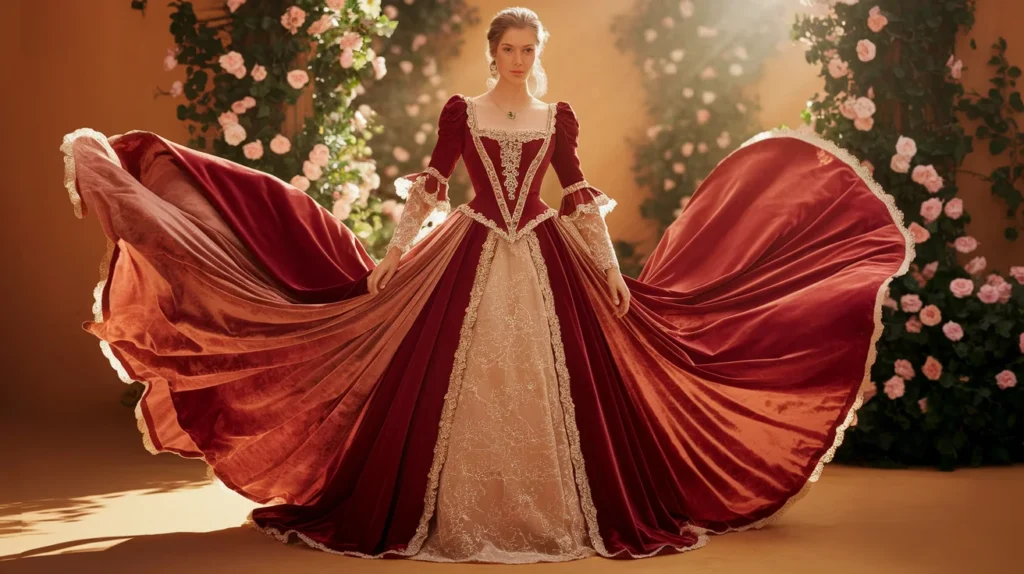The Renaissance era, spanning the 14th century to the 17th century, was a time of artistic and intellectual growth in Europe. Inspired by the grandeur of Greece and Rome, fashion reflected cultural richness, with luxurious fabrics, fine embroidery, and elegantly layered garments. Those of high status and wealth wore outfits that symbolized their rank in courts, showcasing an age where clothing defined one’s identity. If you wish to step back in time, wearing Renaissance dresses is the perfect way to embrace this historical era.
Attending a Renaissance fair, renaissance fair, or renaissance festival offers the perfect opportunity to showcase these magnificent outfits. Whether you’re visiting a grand event in Atlanta or coordinating a school-themed celebration at a high school, these ensembles fit beautifully into different events. They are also ideal for costume parties, historical reenactments, or a themed festival, allowing wearers to express their love for timeless elegance while experiencing the rebirth of classical styles.
Beyond their beauty, Renaissance dresses held symbolic meaning, representing power, refinement, and sophistication. The attention to detail in their craftsmanship showcased deep artistic expression. From accessories like ornate jewelry to intricate fabric designs, these outfits were designed to impress. The influence of this era continues today, with many seeking to transport themselves into its regal charm by embracing its timeless influence.
The Classic Gown with Corset

A classic Renaissance gown with a corset is one of the most iconic styles from the 14th to 17th centuries. These luxurious garments featured intricate embroidery, layers of fabric, and a structured bodice that emphasized an elegant silhouette. This style was worn by noblewomen in Europe, especially in the courts of France and England. The corset provided a refined shape, making the wearer feel both regal and graceful.
Where to Use
- Renaissance fairs, festivals, and themed events
- Historical reenactments
- Weddings with a medieval theme
Where Not to Use
- Casual events or modern formal gatherings
- Outdoor activities requiring a lot of movement
Pros and Cons of The Classic Gown with Corset
Pros:
- Authentic Renaissance aesthetic
- Enhances posture and silhouette
- Ideal for themed events and photography
Cons:
- Can be restrictive and uncomfortable over long periods
- Requires assistance to put on and adjust
- Not suitable for hot weather due to heavy fabrics
The Flowing Peasant Dress
The peasant dress was a staple for commoners and villagers in the Renaissance era. Unlike the structured court gowns, this dress was simple yet elegant, often made of linen or cotton for breathability. It typically had a loose fit, puffed sleeves, and a gathered skirt for ease of movement.
Where to Use
- Casual Renaissance fair looks
- Outdoor festivals and medieval markets
- Comfortable costume options for themed parties
Where Not to Use
- Formal royal court reenactments
- Elite or noble character portrayals
Pros and Cons of The Flowing Peasant Dress
Pros:
- Lightweight and comfortable
- Easy to wear and move in
- Perfect for outdoor and warm-weather events
Cons:
- Lacks the grandeur of noble gowns
- Less intricate detailing compared to royal outfits
- Not as visually striking as corseted gowns
The Tudor-Inspired Dress
This elaborate gown is influenced by the Tudor dynasty, with square necklines, rich velvet fabrics, and heavy embroidery. Worn by nobility in the 16th century, this dress symbolizes status and wealth.
Where to Use
- Tudor-themed events and reenactments
- Royal costume balls
- Stage performances and historical plays
Where Not to Use
- Outdoor summer festivals (due to heavy fabrics)
- Informal medieval events
Pros and Cons of The Tudor-Inspired Dress
Pros:
- Rich and historically accurate design
- Perfect for regal character portrayals
- Exudes a majestic presence
Cons:
- Can be quite heavy and hot
- Expensive to purchase or make
- Requires accessories like headpieces and jewelry for full effect
The Bell-Sleeved Court Dress

This dramatic gown features long, flowing bell sleeves and a fitted bodice, often adorned with gold accents and gemstones. It was worn in the European courts of the Renaissance era.
Where to Use
- Fantasy-themed events and LARPing (Live Action Role-Playing)
- High-society Renaissance fair characters
- Historical fashion showcases
Where Not to Use
- Day-to-day wear
- Casual reenactments of common folk
Pros and Cons of The Bell-Sleeved Court Dress
Pros:
- Elegant and visually stunning
- Perfect for princess and queen-like aesthetics
- Highly photogenic
Cons:
- Sleeves may get in the way during activities
- Requires careful handling to avoid damage
- Not practical for long periods of walking
The Velvet Renaissance Robe
This floor-length robe, often layered over another gown, was a sign of wealth and high status. It was commonly worn by noblewomen and scholars.
Where to Use
- Dramatic royal portrayals
- Cold-weather Renaissance events
- Fantasy-inspired costume parties
Where Not to Use
- Hot summer festivals
- Modern formal events
Pros and Cons of The Velvet Renaissance Robe
Pros:
- Rich, luxurious feel
- Provides warmth in cooler weather
- Adds an extra layer of historical accuracy
Cons:
- Can be very heavy
- Difficult to store and maintain
- Not ideal for active events
The Simple Chemise Dress
A lightweight underdress, often worn beneath heavier garments. It could also be worn alone for a minimalist look.
Where to Use
- Layering under Renaissance gowns
- Casual medieval-inspired outfits
- Folk festivals and LARPing
Where Not to Use
- Formal or elite character portrayals
- Winter Renaissance events
Pros and Cons of The Simple Chemise Dress
Pros:
- Comfortable and breathable
- Can be dressed up or down
- Affordable compared to elaborate gowns
Cons:
- Lacks grandeur on its own
- Not suitable for formal portrayals
- Limited decorative elements
The High-Waisted Renaissance Gown

A fitted bodice with a high waistline and a flowing skirt was popular in the Italian Renaissance.
Where to Use
- Italian Renaissance-themed events
- Artistic and theatrical performances
- Elegant costume balls
Where Not to Use
- Casual fair settings
- Outdoor summer activities
Pros and Cons of The High-Waisted Renaissance Gown
Pros:
- Flattering silhouette for many body types
- Looks ethereal and romantic
- Easy to accessorize
Cons:
- Not as historically versatile as other gowns
- Can be expensive
- Less durable for outdoor wear
The Embroidered Brocade Dress
A heavily embroidered gown, often made of brocade fabric, symbolizes wealth and sophistication.
Where to Use
- Elite court reenactments
- Royal banquet-themed events
- Photography sessions
Where Not to Use
- Casual costume events
- Warm-weather settings
Pros and Cons of The Embroidered Brocade Dress
Pros:
- Highly detailed and intricate
- Exudes luxury and power
- Unique craftsmanship
Cons:
- Very expensive
- Heavy and can be uncomfortable
- Requires delicate care
The Layered Overdress with Undergown
This two-piece ensemble consists of an outer gown (overdress) with an inner dress (undergown), creating a layered, elegant look that was common among noblewomen in the Renaissance era. It allowed for rich fabric contrasts and intricate details, giving it a regal and sophisticated appearance.
Where to Use
- Renaissance fairs and festivals
- Historical reenactments
- Themed banquets and costume parties
Where Not to Use
- Casual costume events
- Modern formal occasions
Pros and Cons of The Layered Overdress with Undergown
Pros:
- Creates a striking, layered effect
- Allows for mix-and-match styling
- Perfect for achieving an authentic Renaissance look
Cons:
- Can be heavy due to multiple layers
- Requires careful fabric coordination
- Not suitable for warm-weather events
The Renaissance Wedding Dress
Inspired by historical bridal gowns, this dress is ornate, flowing, and embroidered, often featuring lace sleeves, pearls, and golden accents. It was worn by high-status women for special ceremonies in the 14th to 17th century.
Where to Use
- Medieval or Renaissance-themed weddings
- Theatrical productions and period dramas
- Grand costume galas
Where Not to Use
- Casual Renaissance fairs
- Outdoor activities requiring flexibility
Pros and Cons of The Renaissance Wedding Dress
Pros:
- Incredibly elegant and regal
- Timeless bridal fashion inspiration
- Detailed craftsmanship makes it stand out
Cons:
- Can be quite costly
- Requires extensive maintenance
- Limited usability outside of weddings or formal events
Conclusion
The Renaissance era brought some of the most iconic, elegant, and luxurious fashion styles in history. These dresses were more than just clothing—they were symbols of status, wealth, and artistic expression. Whether you choose a layered overdress, a flowing chemise gown, or an ornate Renaissance wedding dress, each piece carries the rich cultural heritage of a time when fashion was an art form.
Wearing Renaissance dresses today allows you to step back in time and embrace the grace and sophistication of historical European fashion. Whether attending a Renaissance fair, historical reenactment, or themed event, these dresses help you create an authentic and immersive experience. From puffed sleeves to intricate embroidery, every element reflects the tradition and craftsmanship of the period.
Ultimately, Renaissance fashion remains timeless, continuing to inspire designers, costume enthusiasts, and fashion lovers worldwide. Whether you are drawn to the opulence of noble gowns or the simplicity of peasant dresses, embracing Renaissance attire is a beautiful way to honor the history, elegance, and artistry of this extraordinary era.
FAQs
What fabrics were used in Renaissance dresses?
Renaissance dresses were made from luxurious fabrics like velvet, silk, brocade, and fine linen. Wealthy individuals favored richly embroidered materials, while the lower class wore cotton and wool. The use of gold and silver thread, lace, and pearls added a touch of royalty and sophistication to noble attire. Today, modern reproductions often use polyester blends for affordability and comfort.
Can I wear a Renaissance dress casually?
While authentic Renaissance dresses are elaborate and formal, some modern adaptations allow for casual wear. Simple chemise dresses or corset-style tops can be paired with skirts for a Renaissance-inspired everyday look. However, full-length gowns with layered skirts and embroidery are best suited for themed events, fairs, or historical reenactments.
What accessories should I pair with a Renaissance dress?
Accessories can enhance the authenticity of your Renaissance look. Consider wearing a corset, pearl jewelry, lace gloves, embroidered belts, or a velvet cape. Headpieces such as crowns, veils, and floral wreaths add an extra touch of elegance. Footwear like leather boots or flat slippers completes the outfit.
Are Renaissance dresses comfortable to wear?
Some Renaissance dresses can be heavy and structured, especially those with corsets and multiple layers. However, lighter chemise dresses and flowing gowns are much more comfortable. If you plan to wear one for an extended period, look for modern adaptations with breathable fabrics and adjustable lacing to ensure comfort.
How can I style my hair for a Renaissance look?
Traditional Renaissance hairstyles included braided crowns, loose curls, and pinned-up styles adorned with pearls or ribbons. You can achieve a similar look by using braid extensions, decorative hairpins, or floral accessories. For a queenly appearance, a gold or jeweled tiara adds the perfect finishing touch.